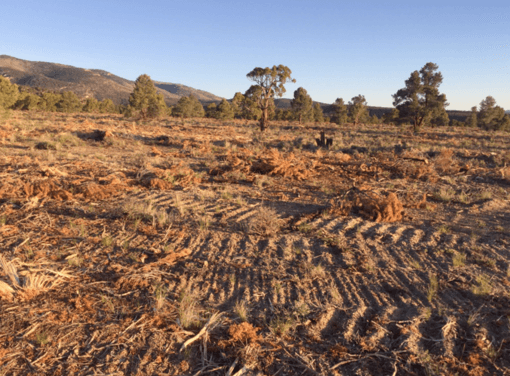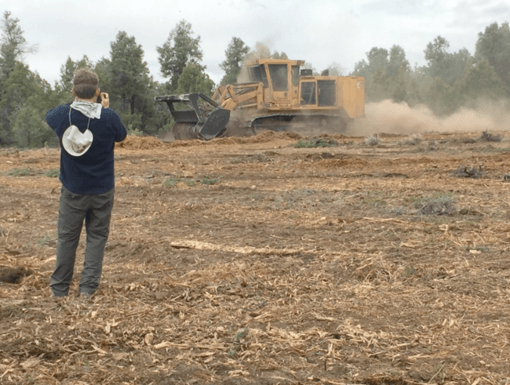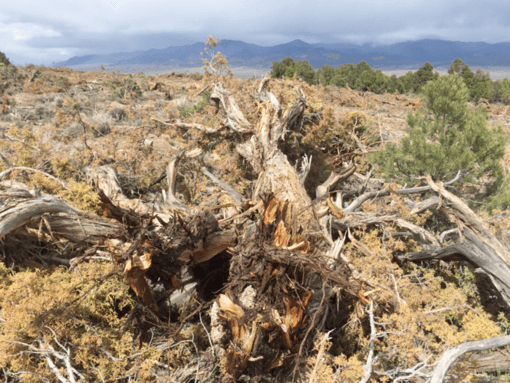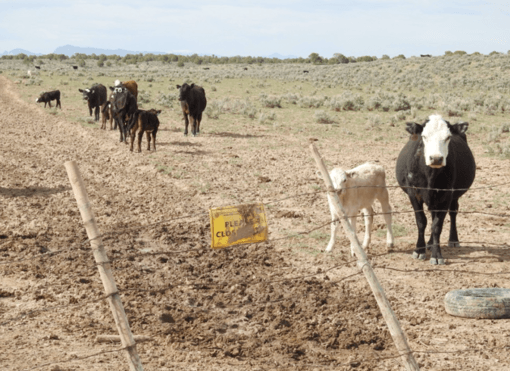
Two previous waves of pinyon-juniper deforestation have swept the Great Basin. A third wave is underway. These forests naturally cloak the regions’ arid mountains and slopes. Explorer journals, Mining District records and Interior’s own General Land Office survey records provide irrefutable evidence that pinyon-juniper historically occupied much of the landscape. Traces of old stumps, charred wood and charcoal kilns persist to this day.
Botanist C.S. Sargent visited central Nevada in 1879, and observed “the forests of Nevada, consisting of a few species adapted to struggle with adverse conditions of soil and climate are of immense age”. Sargent lamented the “terrible destruction of forests … which follows every new discovery of precious metals”. White settlement and exploitation were fueled by pinyon-juniper wood. Trees were clearcut over vast areas – even their roots dug out – to produce charcoal to process gold and silver ore.
The second wave of deforestation followed WWII. In the 1950s-1980s clearcutting, chaining (a ship’s anchor chain is strung between two bulldozers running parallel violently uprooting trees), herbiciding and burning took place. Trees suffered much the same fate as sage did in the government funded War on sagebrush that Rachel Carson wrote of in Silent Spring. Bleak monoculture plantings of exotic crested wheatgrass for livestock forage often followed the carnage – rewarding the same ranchers who had depleted the public lands for private gain. BLM proudly stated the tree destruction was being done for cattlemen. In 1981, Ronald Lanner published The Pinon Pine, a book praising the beauty of pinyon-juniper forests and describing the natural history of the animals intimately intertwined with the trees. Lanner included historical accounts of the pinyon-juniper biome, and exposed the federal government’s forest eradication campaigns “Turning Woodlands into Pastures: The Hard Way”. By the 1990s, large-scale deforestation had waned to some degree, though projects continued especially in backwater BLM Districts. Tree destruction in hazardous fuels projects gained momentum in the Bush years.
Now sage-grouse are being used as cover for the third big wave of deforestation, as federal agencies try to distract the public from the urgent need to list sage-grouse under the ESA. Grouse have been weaponized, and pitted against the pinyon jay, Clark’s nutcracker, mountain bluebird, black-throated gray warbler, ferruginous hawk, pinon mouse and other forest denizens. Pinyon jay populations have already precipitously declined by an alarming 85%, primarily due to deforestation.
The Obama Years
A protracted effort to list sage-grouse came to a head in the Obama years during the tenure of Interior Secretaries Ken Salazar and Sally Jewell. Forest sacrifice was dangled as a bright shiny object in front of the livestock industry who had always clamored for tree eradication and replacement with grass. As a listing decision date drew near, articles about sage-grouse appeared almost daily. Stories fell into two categories: Fearmongering that grouse would destroy the West’s economy and “way of life”, or cheerleading for the huge sums of tax dollars politicians were throwing at vegetation projects and private ranch lands to “conserve” the birds. Agencies like NRCS were begging ranchers to sign up for expensive grouse projects or conservation easements in the middle of nowhere.
An echo chamber of Land Grant college, USGS and BLM range personnel and state Game Department scientists (none of them forest ecologists) ginned up elaborate vegetation models based on “range science” lies. Faulty inputs originated in range claims that the Basin and Range country had historically burned so frequently that forests could not exist in many areas. The forests were largely modeled out of existence. They also claimed any trees present should be growing in a sparse savanna-like community with frequent gentle fires – ignoring that the forests naturally burned in larger “catastrophic” fires under more extreme weather conditions. Their models reinforced claims trees were invading, encroaching, choking the land, sucking up all the water and providing far too many perches for grouse predators (hawks and eagles).
The agency personnel shut out the historical record, and the telltale evidence all around them – old stumps, charred wood, charcoal kilns from the carbonari (charcoal woodcutter) era, and the inherent elevation and precipitation zonation where trees comprise the climax plant community, i.e. the persistent pinyon-juniper forest. Flawed “Ecosite” models of sage communities were turned against sagebrush, too, similarly based on very short fire return intervals used to justify claims that if sagebrush is dense, or old, or not grassy enough in the understory, it too must be treated/destroyed.
There was universal blindness to the historical narratives in The Pinon Pine, and Lanner and Frazier’s more recent summary of the long-term stability of pinyon-juniper communities as shown from review of Mining District records, or accounts such as John Muir’s observations of the nut pine forest and resiny woods as he traveled across the Augusta, Desatoya, Shoshone, Toquima, Hot Creek, White Pine, Egan, Snake and other Ranges circa 1879, including Steep Trails in Steep Trails:
“The entire state seems to be pretty evenly divided into mountain ranges covered with nut pines and plains covered with sage – now a swath of pines stretching from north to south, now a swath of sage; the one black, the other gray; one severely level, the other sweeping on complacently over ridge and valley and lofty crowning dome”.
Western Governors and Game agencies rabidly opposed to ESA listing assembled “working groups” dominated by ranchers and miners to develop grouse plans promoting state and local control. The plans were used to weaken federal efforts. Grazing got a pass. Trees were public enemy #1, along with wild horses present in even the smallest numbers. Elaborate mitigation schemes were embraced to aid mining and energy development. The deforestation frenzy grew.
Listing came to a head in September 2015. Sally Jewell jubilantly announced her Fish and Wildlife Service had found sage-grouse ESA protection was “Not Warranted”. BLM released the new plans, heralded as a billion dollar product of epic collaboration. Public lands grazing continued largely unchecked, despite rancher whining about what a hardship grouse had become for them. Occupied grouse habitat was divided into new categories, with fewer acres recognized as crucial for survival. Development could continue eating up and fragmenting habitat in many areas – justified by having industry throw dollars at mitigation, which translated into vegetation treatments.
BLM’s Fuelbreak and Tree Massacre Smokescreen
Instead of taking better care of the existing sagebrush habitats and protecting them from grazing, development and flammable cheatgrass expansion, or admitting that forested areas are the least likely to burn, the BLM plans focused on radical deforestation. They never considered that forests of younger trees are in the process of recovering from the previous waves of deforestation, re-occupying persistent pinyon-juniper sites. Instead the plans were based on tearing up the Great Basin with a mind-boggling 10,000 linear miles of fuelbreaks devoid of trees or sage, but full of grassy forage plants. 7.4 million forested acres were targeted for destruction across the grouse’s range, equivalent to all the pinyon-juniper expanse in Nevada, an area larger than Vermont.
The Fish and Wildlife Service hid behind the BLM smokescreen, never questioning what such colossal manipulation of native vegetation communities would do to the land.
Cumulatively, the FIAT assessments of the five priority areas identify more than 16,000 km (10,000 mi) of potential linear fuel treatments, approximately 2.99 million ha (7.4 million ac) of potential conifer treatments, more than 2 million ha (5 million ac) of potential invasive plant treatments, and more than 7.7 million ha (19 million ac) of post-fire rehabilitation (i.e., should a fire occur, the post-fire rehabilitation identifies which areas BLM would prioritize for management) within the Great Basin region …
Herbicide-drenched Fuelbreaks give the illusion of BLM being able to control climate-driven wildfires. An EIS is now underway. The radical deforestation allows BLM to claim it is creating new habitat at higher elevations (while cheatgrass sweeps the chronically cow-beat sage below).
Throughout the listing struggle, BLM pumped out NEPA documents, promising that deforestation projects would have “no significant impacts”. By 2015, Ely BLM, Burns BLM offices across Utah, western Colorado, Idaho Burley BLM and Oregon BLM in western juniper country already had stacks of documents aimed at killing trees, with more generated since. The projects typically target sites where there are few sage-grouse and the potential for robust populations is slim – places where no matter how many trees are killed or dollars spent, the land is unlikely to ever be bountiful grouse habitat – too steep, rugged, very arid, or the surrounding sage is already too fragmented and weedy or otherwise lacking the particular combination of features sage-grouse need.
Pockets of old growth forest that survived the previous waves of deforestation are now being destroyed. Even individual old trees are hunted down and killed. Groves of several hundred year old trees, at times no more than 10 ft. tall, are violently uprooted with bulldozer chaining. Pinyon pine can live for 600 years, and Utah juniper even longer. Masticators turn whole trees into piles of wood chips strewn across the land. In an instant, trees grabbed into the maw of bullhogs are ground to oblivion, along with any bird nests, eggs, nestlings, small mammals and lizards sheltering in them.

Bullhog eradicating the forest during migratory bird nesting season in the Egan Range.

Chaining in the Egan Range.
Why – Beyond Grouse?
Public lands ranchers have always hated the trees. Just like native predators are killed as rancher enemies, native trees (and sage) take up space where grass might grow so they must be destroyed. In all of these projects, BLM ballyhoos wildfire suppression benefits, ignoring that deforestation creates hotter, drier, windier, weedier sites with longer fire seasons.
The trees are vilified as water sucking weeds, begrudged the water they transpire. No surprise in country where the Southern Nevada Water Authority floated destruction of greasewood communities on the valley floors because the thorny shrub needed a little water to survive. SNWA purchased ranch property for water rights, in pursuit of a still stymied giant aquifer mining and pipeline scheme to export water to Las Vegas. With the ranches came BLM and Forest Service grazing permits across a million acres.
Trophy hunting predator hating organizations like Rocky Mountain Elk Foundation and Sportsmen for Fish and Wildlife who have the ear of gun-crazed politicians and operatives clamor for tree death and stump fields – prodding agencies to farm public lands for elk and mule deer. Deforestation makes it easier to see, hunt and poach animals. In Nevada, they are closely allied with the mining industry.
BLM funding in Districts like Ely Nevada or Burns Oregon is driven by treatments endlessly laying waste to the land. Staff have been thoroughly indoctrinated in the most heavy-handed forms of land domination. The tree massacres also provide an opportunity for foreign gold mines or other developers to “mitigate” while their pits chew up occupied sage-grouse habitat, draw down aquifers and dry up springs. Development impacts on grouse are then claimed to be mitigated. If Nevada were a nation, it would be the world’s third largest gold producer. Plus the uglier and more unpleasant (hot, dry, weedy, lifeless) the country becomes, the less the public cares about it – facilitating trouble-free grazing, mining and energy development.
Projects Detonate Across the Landscape
Typical BLM NEPA documents parcel out incremental forest destruction over vast areas. They are like a series of ticking time bombs going off – with projects eating away unit by unit for a decade until the forest is almost gone. The devastation that remains following a chaining upheaval or a bullhog’s rampage really does look like a bomb has gone off. In the past 2 years Ely BLM spent $788,000 in Cave and Lake Valleys, $2,000,000 for just one portion of the South Steptoe project in the Egan Range, and millions more on other projects. A contracted masticator or bullhog tree killing can cost over $300 an acre. This does not include BLM planning, cultural site surveys (Native Americans in the Great Basin relied heavily on pine nuts for survival) or other expenses.
If you don’t think the wonderful resinous scent, the beauty of the dark green forest in these stunning landscapes, the tenacity of highly adapted drought tolerant trees, the calls of Pinyon Jays floating through the forest and biodiversity in general are sufficient to warrant forest protection, here’s an example of BLM actually providing a monetary value for the trees being wasted. Elko BLM aggressively (an anomaly for this office) pursued Madeleine Pickens ranch hand for bulldozing 689 trees at Spruce Mountain while re-building a cow water pipeline. Local ranchers like Sagebrush Rebel Demar Dahl were intent on driving Pickens out after she purchased a large ranch hoping to run wild horses salvaged from BLM round ups instead of cattle. BLM issued Pickens a proposed trespass notice valuing the bulldozed trees at $39,402. I watched a bullhog devour that many trees in an hour this spring. BLM, by its own accounting, is wantonly wasting billions of dollars of trees annually. Ironically, Elko BLM was at the very same time in the midst of destroying tens of thousands of acres of pinyon-juniper at Spruce Mountain. Who knows if BLM even included the value of the trees for pine nut production in their tally.

Elko BLM Spruce Mountain chaining. Tiny, ancient trees laid waste.
Projects Brewing
In the million acre Wilson Creek grazing allotment near Pioche, Ely BLM’s recent rangeland land health assessment blames the usual suspects for land degradation – trees, “historical” grazing, and wild horses. BLM seeks to denude 117,000 more acres of forest, and mow or smash sage with a tractor or grass seeder across 40,000 acres (including purging sage “invading” crested wheat seedings), while stocking cows and sheep above numbers that have been able to be grazed in recent years. There are already many past BLM tree and sage killing projects in this landscape. Tracts of forests shown on 1870s General Land Office surveyor maps as Pine Nut Forest have already been chained and cut at unknown expense. BLM’s use of Tebuthiuron herbicide wiped out all the sagebrush around 3 grouse leks and caused a profusion of cheatgrass. Grouse in Lincoln County are at the southern periphery of their range. Loss here would lead to a range contraction. Is BLM’s aim to aid the grouse, or is it to eliminate them because they are an impediment to grazing and development?
Using a ballpark estimate of $150 per acre of forest destroyed (costs vary with treatment type, tree density and size), BLM could readily spend 17 million dollars on more contract tree killing alone. Wilson Creek permittees include SNWA and its domestic sheep herds run to hell and gone across an immense swath of central Nevada – from Cave Valley to Wilson Creek to the Snake Range and borders of Great Basin National Park, where the diseases they harbor threaten the survival of the Park’s native bighorn sheep.

Springtime grazing in Wilson Creek.
Utah has long been ground zero for fomenting forest and sagebrush destruction projects across public lands, and foisting range myths on the public. Trees and sage have been destroyed with a religious zeal. Utah public lands have suffered enormous deforestation impacts hrough the state’s “Watershed Restoration Initiative” and countless BLM projects. This year SUWA ran a TV commercial of bulldozer chaining in the Hamlin Valley on the Utah-Nevada border, and warned of impending BLM pinyon-juniper destruction in Grand Staircase-Escalante Monument’s Skutumpah Terrace and the Paria River watershed.
In Idaho, the Forest Service Minidoka Ranger District plans to destroy Utah junipers in Goose Creek where nearly 2000 cows plus all their calves are turned out in May on top of grouse nests and hatching chicks. The cattle (including those of the Idaho Legislature’s House Speaker Scott Bedke) trample nests and eggs, flush hens, bust up broods and strip protective screening cover exposing nests to predators that thrive on the grazing disturbance. But the Forest claims some scattered tree patches are the real problem causing lek declines.
Western juniper communities in Idaho, Oregon and northeastern California often fare even worse in agency hands than pinyon-juniper does. In the Owyhee juniper country, BLM plans to destroy forests across 600,000 acres, obliterating nearly all the remaining juniper in Idaho located outside a wilderness area. The BOSH project will even strip redband trout streams of the only shade and bank stabilization protection they have in the Owyhee’s severely grazed watersheds. Livestock industry apologists from the University of Idaho Range Department plan to latch onto federal and state funds to “study” and window-dress the ecological havoc being wrought. The project has been temporarily withdrawn by BLM following WLD and other Appeals.
BLM systematically hunts down and destroys (girdles, cuts down, douses with a napalm-like substance and intensely burns) ancient junipers in the Owyhee region, creating ideal conditions for cheatgrass proliferation.
In southeast Oregon, a hugely subsidized Red Rock Biofuels facility built for the Department of Defense for “biomass to jet fuels” will insatiably devour a tri-state region’s western juniper forest (Lakeview BLM, Fremont-Winema Forest, Modoc Forest and others).
Lately, the Jewell era façade of lofty reasons for projects is slipping. A recent Ely justification includes gibberish about Teddy Roosevelt’s legacy, and flatly spells out that the project will provide livestock forage.
In the Trump Era, Zinke’s weakening of the Jewell sage-grouse plans has received much publicity. With grazing, there really wasn’t much to gut. The Zinke plan changes like increased “flexibility” just add to the pervasive lack of rancher accountability already commonplace on public lands. Radical deforestation survives unscathed.
Now Congress just enacted a Farm Bill that folded in previously introduced legislation stripping environmental review of pinyon-juniper projects – the “Sage-grouse and Mule Deer Habitat Conservation and Restoration Act”, a bipartisan attack on the trees. The Farm Bill amends the Healthy Forests Restoration Act to enable BLM and the Forest Service use of Categorical Exclusions (a minimal NEPA checklist) to destroy up to 4500 acres (over 7 square miles) of pinyon-juniper trees in one fell swoop. It specifically targets trees, putting them in the same category as weeds. So much for some environmental group claims that the bad things had been removed from the Farm Bill.
Think of the climate madness of this radical deforestation destroying the ability of the land to buffer climate change stress, and the loss of drought tolerant forests that absorb CO2. BLM pays contractors as much as $500 an acre to cut down trees, bulldoze them into piles, then sets the piles ablaze scalding the soil, releasing carbon and creating innumerable bare burned sites where cheatgrass soon thrives.
It’s really a matter of just how fast sage-grouse extinction will happen with either version (Jewell’s or Zinke’s) of the BLM grouse plans under the current public land management paradigm. This tragedy is made worse because the pinyon-juniper biome across much of the West is being purposefully destroyed as the bird’s downward trajectory plays out. Desolation.
All photos by Katie Fite.